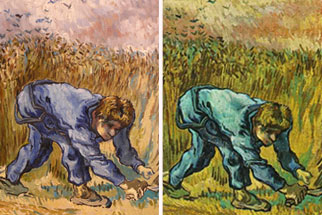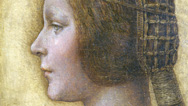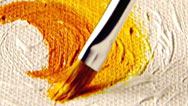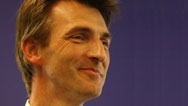Catching a Copy
- By Susan K. Lewis
- Posted 06.01.08
- NOVA scienceNOW
How do you tell a masterpiece from a master forgery (or a well-intentioned imitation)? Computer scientist Eric Postma, an expert in artificial intelligence and digital art authentication, leads you through the process his team takes to pinpoint an oddball in a group of otherwise authentic paintings.
 Launch Interactive
Launch Interactive
See if you can tell a fake from a genuine van Gogh, and hear how one team of computer scientists did it.
Transcript
Catching a Copy
NARRATOR: A hundred years ago, the job of authenticating art - telling genuine paintings from forgeries--was left to art connoisseurs. Eric Postma of the University of Maastricht explains.
ERIC POSTMA: Art historians just assessed paintings by looking at their provenance, so the history of who owned the painting and when was it sold to another person, and also by their visual judgment. So art historians have seen a lot of paintings and they recognize the styles of painters. But, unfortunately, sometimes they were wrong, because people make mistakes, and they were fooled by forgeries or fakes.
NARRATOR: Around the middle of the 20th century, science started coming into play. Art historians were helped by experts who could analyze the chemistry of paint, for instance, or look at canvases with infra-red and x-ray light. But in today's digital age, a new breed of scientists is joining the effort. And Postma is at the forefront.
ERIC POSTMA: The collaboration between computer scientists--the nerds or the cool people who only work with computers and numbers--and art historians which have a totally different approach toward paintings and the assessment of paintings is interesting in many ways, because it's a kind of combination of two totally different cultures that have to learn to communicate and learn to understand each other's ways of dealing with problems.
NARRATOR: As a professor of artificial intelligence, one of the problems Postma works on is how to make computers recognize objects a little like humans do. He forayed into the art world somewhat by chance.
ERIC POSTMA: My first interest in the analysis of images led to the development of an automatic learning technique that can recognize images. And I was interested in evaluating this technique, a kind of computer program. And after a visit to an exhibit on Impressionist paintings, I thought, "Well, it would be nice to try my technique on five or six impressionist paintings and to see whether my technique can classify a painting according to the maker or author of the painting." And it turned out to be very successful.
NARRATOR: From this success, Postma went on to approach the Van Gogh Museum in Amsterdam. The museum gave him access to over 200 paintings, and his team set out to create a computer program that could tell a genuine van Gogh from a forgery.
ERIC POSTMA: Once we had access to the dataset of the van Gogh Museum, the tedious job was to digitize all of the ektachromes, an ektachrome is a large slide. And my PhD. student, Igor Berezhnoy had the tedious job of scanning all these ektachromes and to obtain carefully prepared digital reproductions, and then to analyze these reproductions using the computer. But you can look for all sorts of features in these paintings. So the first step we took was talk to the experts of the van Gogh Museum and other experts and ask them, "Where are these features that an expert sees or thinks is hiding the hidden signature of van Gogh?" And they all suggested it was in the fine brushstrokes of van Gogh. So our analyses focused from the beginning on the fine brushstrokes. And another feature was color, complimentary colors.
NARRATOR: The computer may be able to detect colors and count the number of brushstrokes. But how, exactly, does it "see" one of van Gogh's masterpieces? Is it at all like how we humans would?
ERIC POSTMA: The way humans look at paintings is always biased in the sense that we have knowledge about the world and knowledge about van Gogh and about paintings or about scenes, and a computer does not have this knowledge unless it is trained to recognize these objects. In a sense, the same is true for human beings; if you have never seen a chair, you cannot recognize a chair. So, what we can do is to use our model to train the computer on a lot of van Goghs and a lot of brushstrokes that belong to van Gogh and that do not belong to van Gogh, and then the computer is able to learn the differences.
NARRATOR: In 2006, Postma put his method to a critical test.
ERIC POSTMA: The best test for our method was to see whether our method would be able to pick out an established forgery of a van Gogh painting, the so-called Wacker forgery. And it's called Wacker because it was sold by a German art dealer called Otto Wacker. We were interested to see whether our method would be able to pick that one out. And it turned out that it had a quite different pattern than all the other van Goghs that we studied.
NARRATOR: You can see a representation of what Postma's computers pick-up right here on this page.
ERIC POSTMA: On the website we have visualizations of the analyses that we do in which the original paintings are replaced by what we call activity maps. The brighter colors in these images reflect larger activity of our brushstroke or contour-detecting algorithms. So, in the activity maps you see that the border areas are much lighter than the other areas, and this has to do with the way that our technique reflects the functioning of the visual system of human beings. So our visual system is highly tuned to the detection of transitions--light-dark or color transitions--and this is also true for our technique.
NARRATOR: So the edges of objects like the bedposts or man's jacket appear whiter. And when you compare the black and white activity maps of all five paintings, you can also see something else.
ERIC POSTMA: What we see is that the fake, the Wacker fake, that sticks out has much more white areas than the other paintings. And it means that the Wacker forgery has too many brushstrokes. So one of the features of van Gogh paintings is that he didn't use too many brushstrokes to make his paintings. And someone who tries to copy him might overdo it, so that's why you see so many white areas.
NARRATOR: When NOVA scienceNOW put Postma's technique to another test, with a copy of our own, the results were also clear.
ERIC POSTMA: When we tested the six painting we found that the NOVA copy of The Reaper clearly stood out in the number of brushstrokes in the same way that we found in the Wacker forgery where there were too many brushstrokes as compared with a genuine van Gogh.
NARRATOR: And how long did the analysis take them?
ERIC POSTMA: It took us about five minutes per painting.
NARRATION: Just five minutes?
ERIC POSTMA: Computers are very fast nowadays.
NARRATOR: Postma and his colleagues are now training their computers to recognize other aspects of paintings, improving methods that may one day be used for nabbing forgeries.
ERIC POSTMA: Our technique is still quite young in development, and it has not been used yet for detecting fakes or forgeries. Actually what we try to do in our consortium with the other teams and the van Gogh Museum and other museums, is try to set up more awareness amongst cultural historians about the strengths and limitations of these techniques. Because we don't believe that a computer scientist should take over the job of cultural historians, but they should work together. And through this collaboration we can achieve a better assessment of paintings.
Credits
Images
- (The Reaper, The Seaview at Saintes Maries forgery, The Zouave, The Bedroom, The Yellow House)
- Courtesy Van Gogh Museum;
- (The Reaper forgery)
- Courtesy Charlotte Caspers;
- (computer scans)
- Courtesy Eric Postma
Related Links
-

Mystery of a Masterpiece
Art experts investigate whether a portrait sold for about $20,000 in 1998 is actually a lost Leonardo worth millions.
-

Art Authentication
See if clever computer algorithms can distinguish a master forgery from a masterpiece.
-

Art Authentication: Expert Q&A
Computer scientist Eric Postma of Maastricht University answers questions about the digital analysis of paintings.
-

Profile: Hany Farid
This self-proclaimed "accidental scientist" is a digital detective inventing new ways to tell if photos have been faked.
You need the Flash Player plug-in to view this content.



